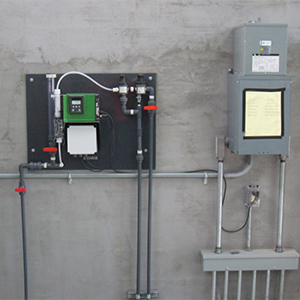 Romtec Utilities designs many different types of odor control systems for wastewater lift stations. Although there are a lot of odor control technologies available, there are two main thoughts behind odor control for wastewater. The first thought is referred to at Romtec Utilities as “passive odor control.” The second thought is referred to as “chemical feed systems.”
Romtec Utilities designs many different types of odor control systems for wastewater lift stations. Although there are a lot of odor control technologies available, there are two main thoughts behind odor control for wastewater. The first thought is referred to at Romtec Utilities as “passive odor control.” The second thought is referred to as “chemical feed systems.”
These two ideas are not simply a breakdown of different technologies; they represent two different cultures of wastewater management. Odor from wastewater is one problem, but odorous gasses are simply a symptom of several other problems that result from wastewater turning septic. Passive odor control is centered on eliminating odor particles from air that escapes the lift station. Chemical feed systems pump chemicals into the lift station to prevent the sewage from turning septic and causing odors.
The reason why these two approaches are so different is because passive odor control does not stop wastewater from turning septic and only treats the symptom. The reality is that septic wastewater poses a lot of different problems. When wastewater begins to turn septic, the bacteria in the sewage will begin to produce higher levels of hydrogen sulfide, ammonia, methane, and other odorous substances. In addition to the unpleasant smells, these chemicals are corrosive, flammable, and difficult (e.g. expensive) to treat. Passive odor control does not eliminate these chemicals.
A chemical feed system will use one of many different chemicals to prevent stagnant wastewater in a lift station from turning septic. This approach not only eliminates odorous off-gassing; it eliminates the difficulties of pumping and treating septic wastewater. Chemical feed systems cost more initially to design and install than most passive odor control systems, but over the life of a lift station, treating septic wastewater will typically cost much, much more in terms of treatment and system maintenance.
The choice between a passive odor control system and a chemical feed system is often reliant upon the capabilities of the local treatment facility and any applicable design standards. Understanding the differences between these two schools of thought can help develop a successful lift station or wastewater collection system.
Of course, Romtec Utilities advocates that the best odor control is no odor control. Wastewater only becomes an odor problem when it stagnates and becomes septic. If wastewater is pumped quickly and is consistently moving, then there is no septic wastewater and very few odorous gasses. If this option is available, it will be the lowest cost solution for eliminating odors. There will typically be more pump starts required with this approach, but modern pump maintenance is a lot more affordable than handling septic wastewater or managing an entire odor control system.
For an in-depth look at how Romtec Utilities handles odor control, look at our Tech Info section on this topic or view our Odor Control White Paper.


Comments 1
We are interested in finding something to help with odor control at our lift station